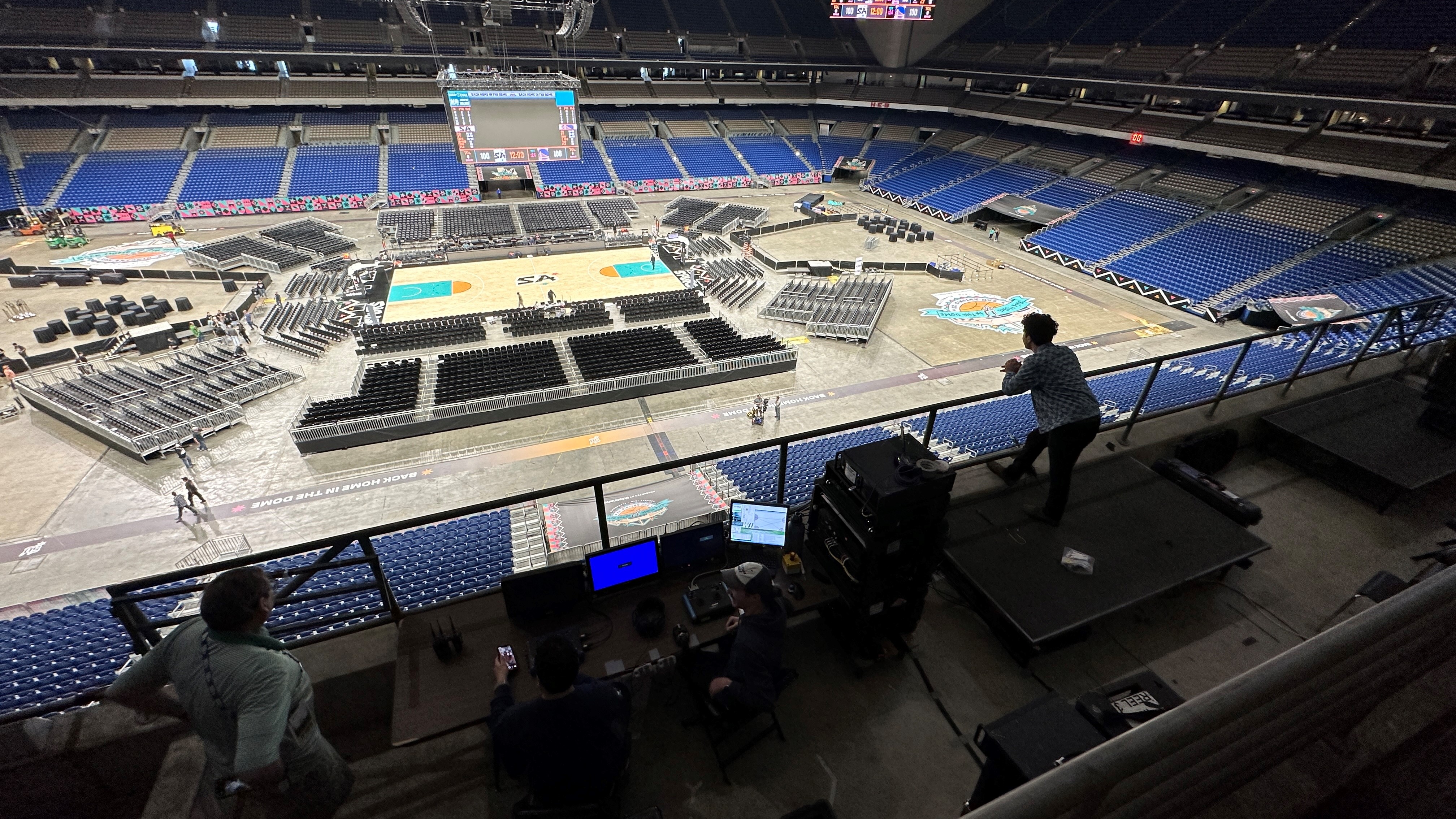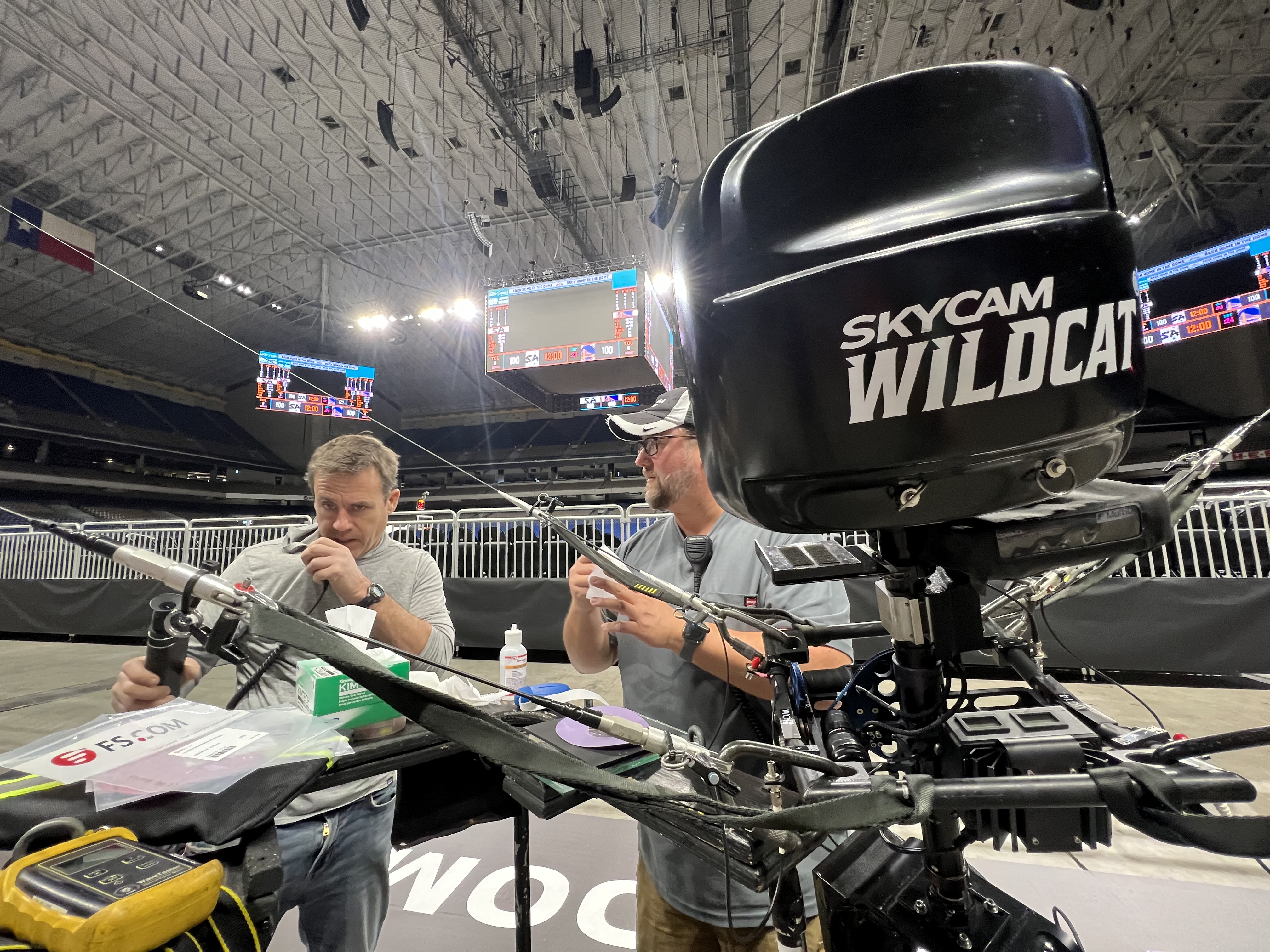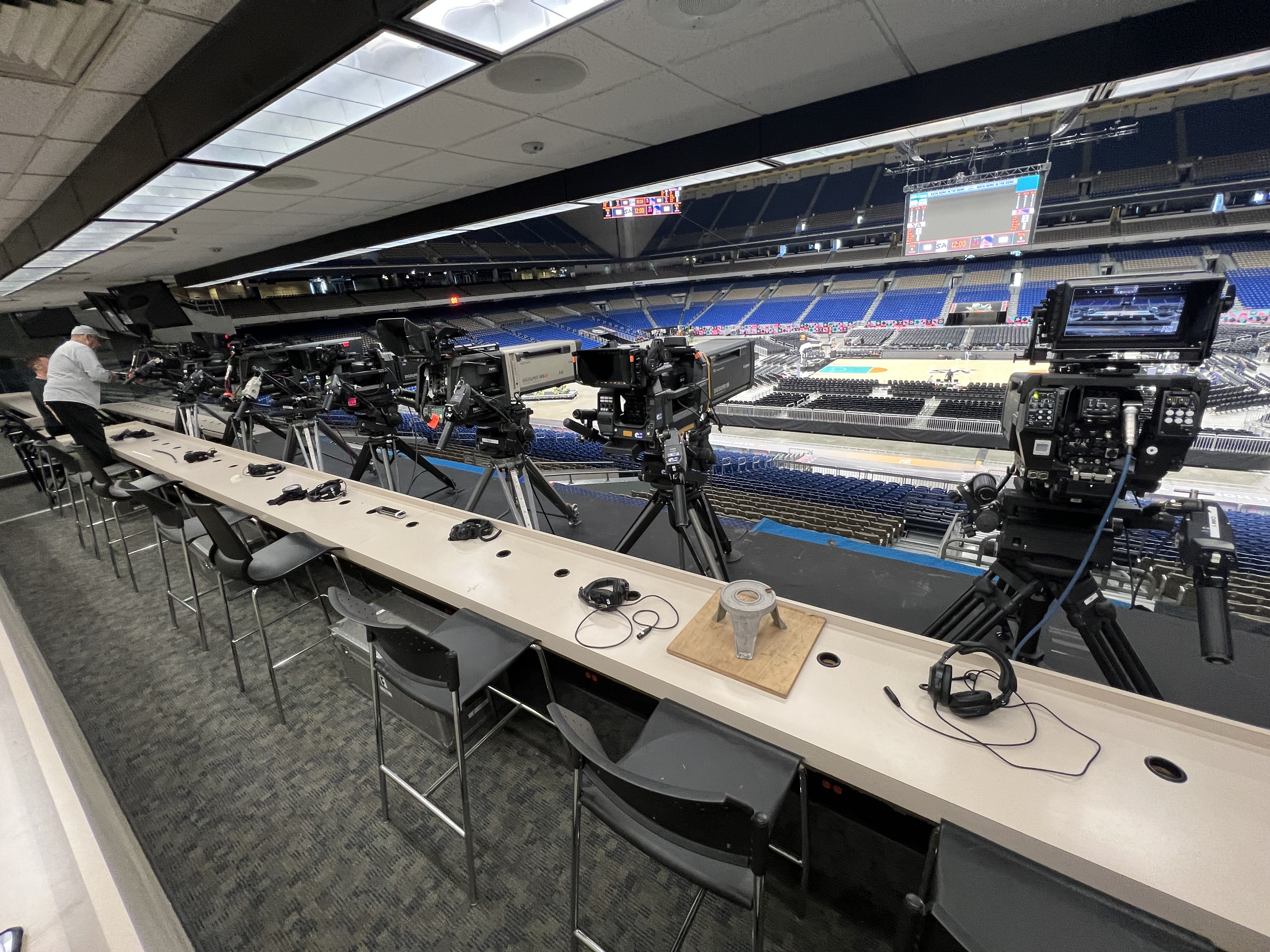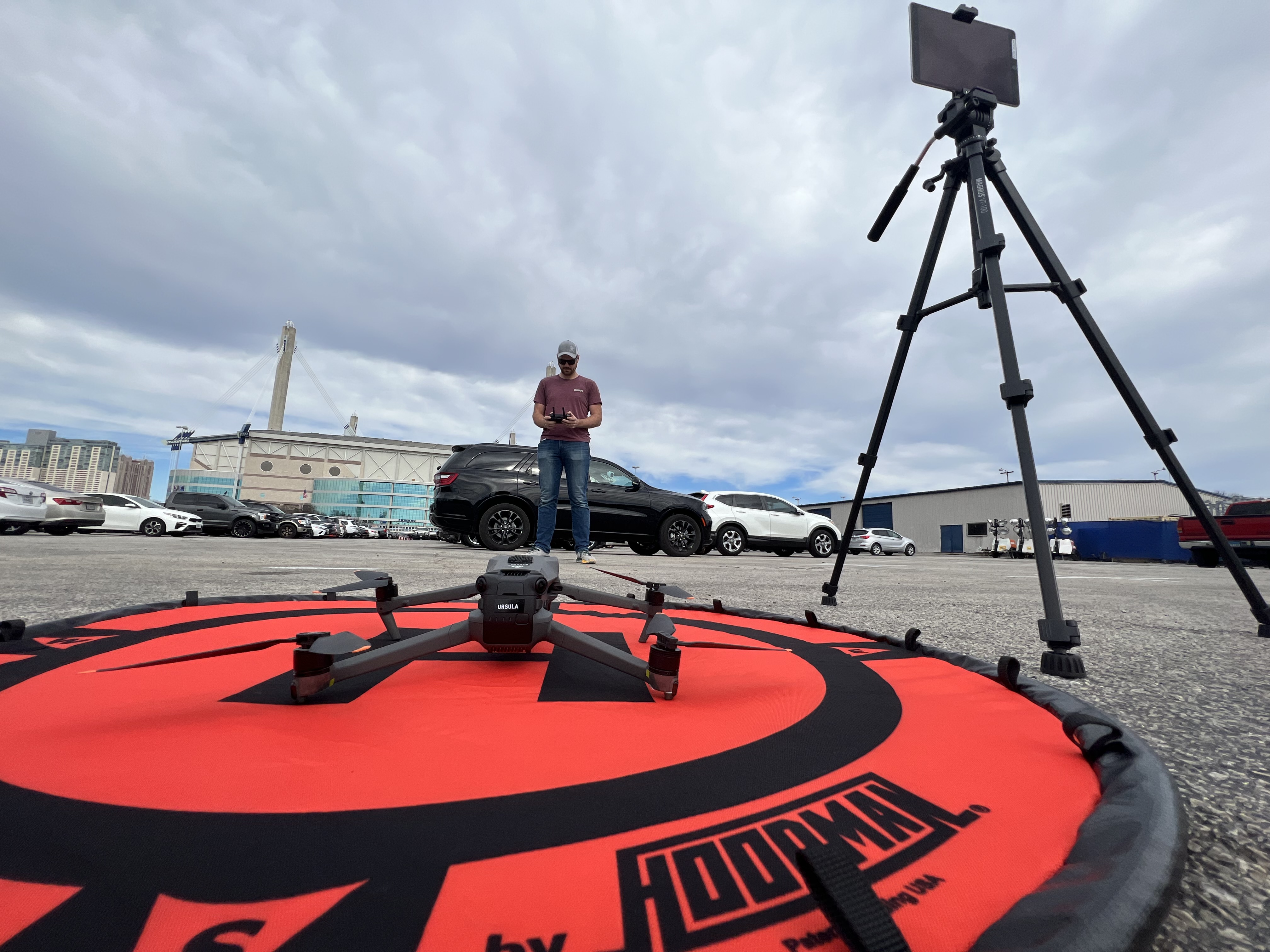ESPN to ‘Document History’ in Spurs' Record-Setting Return to Alamodome
Producing an NBA game—with a record attendance—in a football facility brings unique challenges, opportunities

The San Antonio Spurs are ready to take a record-setting step forward, with tonight’s contest against the Golden State Warriors, marking the first time a team has approached selling out a football stadium for a regular season NBA game.
How did that circumstance arise? By the franchise taking a step backwards. The Spurs are celebrating their 50th anniversary in the Alamo City by playing a game in its former home arena. And that spelled opportunity for ESPN.
New Dimensions
The Spurs, who now play at the AT&T Center, are returning for tonight’s game to their home from 1993 to 2002, the Alamodome ― an indoor stadium with a capacity of 65,000 for football—but this time sans that huge curtain that was intended to make the venue more intimate. Tonight’s configuration will encompass the entire stadium, which means new dimensions for ESPN to address.
This is a big event and an opportunity to show what we can do on a bigger stage."
Tim Corrigan, ESPN
“First and foremost, we’re covering the game. However, this time the broadcast is also about documenting history,” said ESPN vice president of production Tim Corrigan. “So we’ve made some adjustments given the unusual circumstances, such as higher positioning of the game cameras in the lower bowl to encompass the scene and present a better sense of scale.”
That basically means more of everything. The crew headcount will reach about 65, which is more than the usual 40-50 for an NBA game; and instead of the usual 10 cameras, ESPN will use 14. The Sony 2500, P50 and 4300 1080ps, “are needed for their high frame rate and super slo-mo capabilities, for the game coverage,” said Eddie Okuno, senior remote operations specialist for DMED-ESPN.
In addition, ESPN will share cameras with the Spurs and Warriors, who will present their home broadcasts (on Bally Sports Southwest and NBC Sports Bay Area, respectively). “That approach is common during the season,” said Corrigan, “because it makes for an incredible network.”
A Wider View
Also part of the special broadcast will be a four-point Skycam Wildcat with a Sony P50 and wide angle lens for game and scenic coverage. It will be used like the camera that hangs above the field in an NFL game, with the capacity to run the 120-yard length of a football field from 65 feet in front of the press box ― or that half of the field, since the Alamodome’s video board will be hanging lower than usual.
Get the TV Tech Newsletter
The professional video industry's #1 source for news, trends and product and tech information. Sign up below.

“We have a great deal of space to work with,” said Corrigan. “Howeverr it’s important to understand that this broadcast is not akin to broadcasting a football game just because it’s in a football stadium.”
The incorporation of Skycam is more to tell the story of the game than focusing on the actual coverage of the action. “It will allow us to document the players’ walk from the locker room to the court, for instance,” he said, “and there will be numerous panoramic shots of the packed stadium.”
Another touch by ESPN will be to use longer lenses, namely the Canon 122X and the 27X, on the game camera since it will be farther from the action “to better present the scale of the entire venue,” said Okuno, also noting the Sony Alpha One shallow depth of field RF camera that uses mirrorless technology “to create a cinematic look.”

As for the rest of the technical setup, the network also installed all home run dark fiber provided by Bexel earlier this week, then the rest of that part of the install yesterday.
ESPN will produce the game via its two main NBA trucks from the NEP Group: EN3A and EN3B, which house the Grass Valley dual-suite switchers, seven EVS XT4K units and an edit room that includes a dedicated EVS unit for editing the player’s and coach’s microphones.
In addition, one player from each team, each head coach and one referee, will wear Q5X mics. Shure Axient is providing the other mics for the talent, which are all also rentals from Bexel, an NEP company and a long-time partner of ESPN.
NBA Drone
A DJI drone will also accentuate the broadcast. It will be used from the loading dock of the adjacent Gonzales Convention Center, with clearances managed by the DMED drone operations team led by Manager Ryan Humble, who is an FAA certified pilot.

Humble said the plan is to fly the drone from the Convention Center, starting with the pregame festivities throughout broadcast “to get shots from around the venue, the Riverwalk District, the city skyline and anything that’s needed.
“We’ll be working with a visual observer,” he said, noting battery changes every 30 minutes and adding, “we’ll use bonded cellular to transmit drone video to the two mobile units and Zoom for our program return.”
Getting the Signal from Here to There
Concerning transmission, the Alamodome does not offer NBA the necessary signal specs, so it will be sent via fiber to the AT&T Center, then on to ESPN headquarters in Bristol, Conn., and to the NBA technical operations center in Secaucus, N.J.
While the event will bring back old memories, much has changed since the team moved out two decades ago. “I used to work at NBC, which had the NBA contract the last time the Spurs played at the Alamodome,” said Okuno, “but the technical setup today is different. “
Corrigan knows the feeling. “We haven’t often worked in such scenarios, because ESPN didn’t have the rights when the handful of other NBA stadium or outdoor games were played,” he said.
But with the attendance record and today’s technology, it’s a new day. “This is a big event,” he said, “and an opportunity to show what we can do on a bigger stage.”
Mark R. Smith has covered the media industry for a variety of industry publications, with his articles for TV Technology often focusing on sports. He’s written numerous stories about all of the major U.S. sports leagues.
Based in the Baltimore-Washington area, the byline of Smith, who has also served as the long-time editor-in-chief for The Business Monthly, Columbia, Md., initially appeared in TV Technology and in another Futurenet publication, Mix, in the late ’90s. His work has also appeared in numerous other publications.

